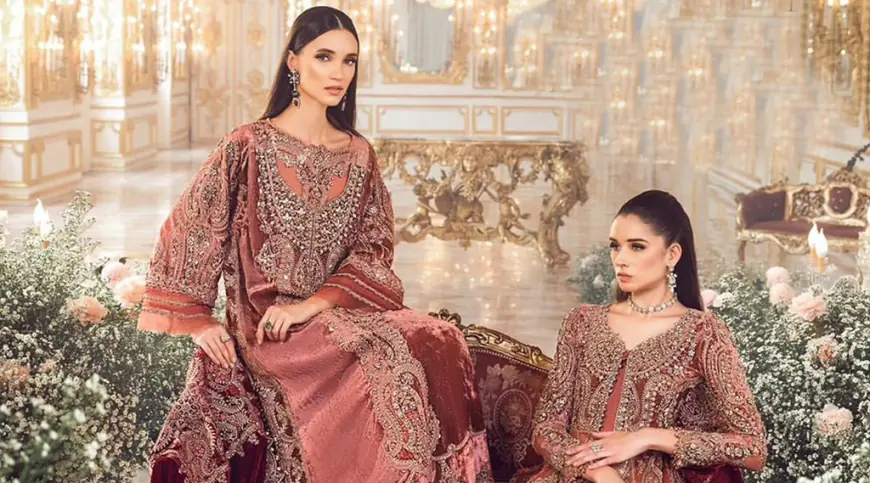Why Rafia Khas Represents the New Era of Contemporary Fashion
The emergence of distinctive design philosophies in contemporary fashion reflects the industry's evolution toward more meaningful and culturally grounded aesthetics. This transformation represents a departure from purely trend-driven fashion toward approaches that combine artistic vision with cultural authenticity. The result is sophisticated fashion that resonates with consumers seeking depth and significance in their wardrobe choices.

The emergence of distinctive design philosophies in contemporary fashion reflects the industry's evolution toward more meaningful and culturally grounded aesthetics. This transformation represents a departure from purely trend-driven fashion toward approaches that combine artistic vision with cultural authenticity. The result is sophisticated fashion that resonates with consumers seeking depth and significance in their wardrobe choices.
Innovative Design Philosophy in Modern Fashion
Contemporary fashion increasingly emphasizes originality and artistic expression over mass market appeal. This shift has created space for design approaches that prioritize creative vision and cultural storytelling through fabric selection, pattern development, and silhouette innovation. These philosophies appeal particularly to fashion-conscious consumers who value unique pieces that reflect personal style preferences.
The integration of traditional craftsmanship techniques with modern aesthetic sensibilities creates fashion that feels both timeless and current. This approach resonates across international markets where consumers appreciate authentic design stories that connect them to broader cultural narratives while meeting contemporary style requirements.
Quality Standards That Define Contemporary Luxury
Modern luxury fashion has redefined quality standards to encompass not just material excellence but also design innovation and cultural authenticity. These elevated standards require attention to every detail, from fabric selection and construction techniques to finishing details and overall aesthetic coherence.
Contemporary consumers expect luxury fashion to deliver experiences beyond mere material quality. The storytelling aspects, cultural connections, and artistic vision behind design choices have become integral components of luxury value propositions that justify premium pricing and build lasting brand loyalty.
Cultural Heritage Integration in Global Markets
Successful contemporary fashion brands demonstrate how cultural heritage can be preserved and celebrated while appealing to international audiences. This approach requires sophisticated understanding of both traditional techniques and global fashion preferences, creating designs that feel authentic without appearing outdated or overly ethnic.
The key lies in extracting essential cultural elements and reinterpreting them through contemporary design language. This process creates fashion that honors heritage while remaining accessible and appealing to diverse consumer bases across the USA, UK, Australia, Canada, and Middle Eastern markets.
Sustainable Luxury Through Thoughtful Production
Contemporary fashion leadership increasingly includes commitment to sustainable practices that align with modern consumer values. This encompasses responsible sourcing, ethical manufacturing, and quality construction that supports slow fashion principles over disposable consumption patterns.
The emphasis on garment longevity through superior construction and timeless design reduces environmental impact while delivering better value to consumers. This sustainable luxury approach appeals to environmentally conscious buyers who seek fashion choices that align with their personal values.
Global Recognition and Market Positioning
Contemporary fashion brands that successfully balance tradition with innovation often achieve international recognition that transcends their original cultural contexts. This global appeal demonstrates the universal appreciation for authentic design stories and quality craftsmanship that speaks to human aesthetic sensibilities across cultural boundaries.
The international success of culturally grounded contemporary fashion validates approaches that prioritize authenticity over purely commercial considerations. This validation encourages continued innovation in tradition-modernity fusion techniques that create distinctive market positioning.
Artisanal Craftsmanship in Modern Production
The preservation of traditional craftsmanship within contemporary production frameworks ensures that valuable skills and techniques continue evolving rather than disappearing. Modern brands that prioritize artisanal elements create employment opportunities for skilled craftspeople while delivering authentic value to consumers seeking genuine handcrafted details.
This approach to production creates fashion that cannot be easily replicated through mass manufacturing, providing competitive advantages based on authenticity and skill rather than price competition alone.
Design Language That Speaks to Global Audiences
Developing design languages that communicate effectively across cultural boundaries requires deep understanding of visual aesthetics and cultural symbolism. Successful contemporary fashion creates pieces that feel familiar and accessible to international audiences while maintaining distinctive cultural characteristics that provide authentic differentiation.
The sophistication of this design approach lies in its subtlety and refinement. Rather than obvious cultural symbols, the best contemporary fusion fashion incorporates cultural elements through proportions, color relationships, and construction details that create recognizable but not stereotypical aesthetic signatures.
Technology Enhancement of Traditional Techniques
Modern technology enables the enhancement of traditional craftsmanship without replacing its essential human elements. Digital design tools, precision cutting equipment, and advanced finishing techniques support artisanal skills while improving consistency and efficiency in production processes.
This technological integration allows contemporary fashion brands to maintain traditional quality standards while scaling production to meet international demand. The balance between technological enhancement and handcrafted authenticity creates products that satisfy both quality expectations and cultural authenticity requirements.
Market Leadership Through Authentic Innovation
Leadership in contemporary fashion requires authentic innovation that creates genuine value for consumers rather than superficial trend following. This leadership manifests through consistent delivery of designs that feel both fresh and grounded in meaningful cultural context.
The success of authentic contemporary fashion approaches demonstrates growing consumer appetite for fashion that provides depth and significance beyond surface aesthetics. Brands like Rafia exemplify this leadership by creating collections that honor traditional craftsmanship while pioneering contemporary design innovations.
Building Fashion Legacy Through Cultural Preservation
Contemporary fashion brands that successfully integrate cultural heritage with modern innovation contribute to cultural preservation while building lasting fashion legacies. This approach ensures that traditional techniques and aesthetic principles continue influencing future generations of designers and consumers.
The responsibility of cultural preservation through fashion extends beyond commercial success to include education and inspiration for future creative development. Brands like Rafia demonstrate how contemporary fashion can serve as vehicles for cultural continuity while meeting evolving market demands and consumer expectations across global fashion communities.
What's Your Reaction?
 Like
0
Like
0
 Dislike
0
Dislike
0
 Love
0
Love
0
 Funny
0
Funny
0
 Angry
0
Angry
0
 Sad
0
Sad
0
 Wow
0
Wow
0
















































